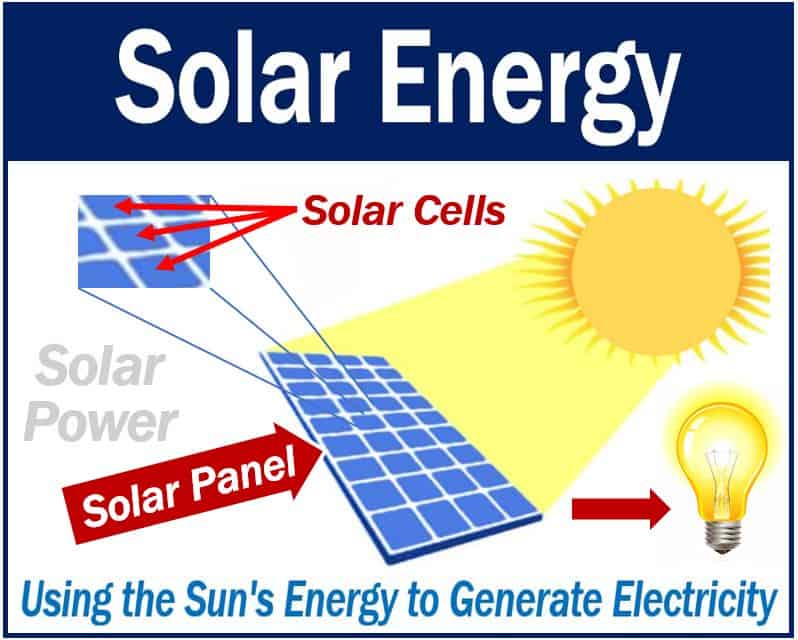Solar Energy refers to capturing the Sun’s energy and converting it into electricity. We can then use that electricity to light up our homes, streets, and businesses, and power our machines. We can also use the term solar power with the same meaning.
The Sun’s energy is in the form of solar radiation. Solar radiation makes the production of solar electricity possible.
Recent enhancements in photovoltaic cell efficiency continue to improve the cost-effectiveness of solar installations, further driving the adoption of solar energy globally.
China is the world’s largest generator of solar energy. Today, it has a solar energy capacity of 130 gigawatts.

How does solar energy work?
A photon is a basic unit that makes up all light; it is a bundle of electromagnetic energy.
When photons strike a solar cell, they loosen electrons from their atoms. If we attach a conductor to a cell’s negative and positive sides, we have an electrical circuit.
When the electrons flow through the circuit, they generate electricity.
Solar panel – solar cell – solar array
Solar panels (solar modules) consists of many solar cells. When there are many panels wired up together, we have a solar array.
The amount of electricity a solar panel produces depends on three factors:
- Its size.
- The efficiency of the solar cells within that panel.
- How much sunlight hits the solar panel.
Solar energy – renewable energy
Solar energy is renewable energy. Renewable energy is energy whose source never runs out. We can never use up the energy source completely.
Solar energy, wind energy, and geothermal energy, for example, have renewable sources of energy in a human timescale. The energy from the Sun, in our personal timescale, never runs out. Wind is always there, and heat from below Earth’s surface (geothermal energy) is continuous.
Biomass – energy from plants and other organic material – is also renewable. Humans have been burning wood to heat their homes and cook their food for thousands of years.
Hydropower involves capturing the energy from moving or falling water. Moving or falling water is always available. Therefore, hydropower is renewable power. Tidal power is a type of hydropower.
Generating electricity when it’s cloudy
Solar power electricity systems or photovoltaics (PV) do not need direct sunlight to work. Even on a cloudy day, they can still generate electricity.
Solar energy – benefits
The UK’s Energy Saving Trust lists these four benefits for households that use solar energy:
- Sunlight is free. Therefore, as soon as you have paid for the initial installation, your electricity costs are virtually free.
- The UK government has a Feed-in Tariff scheme. The scheme pays people for the electricity they generate, even if they use it. Many countries across the world have similar schemes.
- Sell electricity to the grid. The electricity grid will pay households for the electricity that they export through the UK’s Feed-in Tariff scheme. Similar schemes also exist in other countries.
- Lower carbon footprint. Solar energy is a green renewable energy. It does not release carbon dioxide and other gases that contribute to climate change.
A typical PV system for an average household, for example, could save approximately 1.2 to 1.7 tonnes of carbon annually.
Climate change refers to the long-term change in Earth’s average temperatures and weather patterns. When long-term temperatures rise, we refer to it as global warming.
Global temperatures are currently rising at progressively accelerating rates. If we do not take drastic action soon, we may have a serious problem by the middle or end of this century.
The Sahara desert could generate more electricity than the world needs just with solar and wind energy.
Innovations in solar technology are constantly advancing, with recent developments including bifacial solar panels which can absorb light on both sides, increasing potential energy generation.
Solar energy storage solutions are evolving, with solar batteries seeing improvements in capacity and lifespan, which enhances the reliability of solar power as a consistent energy source.
